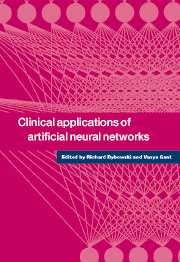Book contents
- Frontmatter
- Contents
- List of contributors
- 1 Introduction
- Part I Applications
- Part II Prospects
- 8 Recent advances in EEG signal analysis and classification
- 9 Adaptive resonance theory: a foundation for ‘apprentice’ systems in clinical decision support?
- 10 Evolving artificial neural networks
- Part III Theory
- Part IV Ethics and clinical prospects
- Index
10 - Evolving artificial neural networks
Published online by Cambridge University Press: 06 October 2009
- Frontmatter
- Contents
- List of contributors
- 1 Introduction
- Part I Applications
- Part II Prospects
- 8 Recent advances in EEG signal analysis and classification
- 9 Adaptive resonance theory: a foundation for ‘apprentice’ systems in clinical decision support?
- 10 Evolving artificial neural networks
- Part III Theory
- Part IV Ethics and clinical prospects
- Index
Summary
Introduction
Artificial neural networks (or simply neural networks) are computer algorithms loosely based on modelling the neuronal structure of natural organisms. They are stimulus–response transfer functions that accept some input and yield some output, and are typically used to learn an input–output mapping over a set of examples. For example, the input can be radiographic features from mammograms, with the output being a decision concerning the likelihood of malignancy.
Neural networks are parallel processing structures consisting of non-linear processing elements interconnected by fixed or variable weights. They are quite versatile, for they can be constructed to generate arbitrarily complex decision regions for stimulus–response pairs. That is, in general, if given sufficient complexity, there exists a neural network that will map every input pattern to its appropriate output pattern, so long as the input–output mapping is not one-to-many (i.e. the same input having varying output). Neural networks are therefore well suited for use as detectors and classifiers. The classic pattern recognition algorithms require assumptions concerning the underlying statistics of the environment. Neural networks, in contrast, are non-parametric and can effectively address a broader class of problems (Lippmann 1987).
Multilayer perceptrons, also sometimes described as feedforward networks, are probably the most common architecture used in supervised learning applications (where exemplar patterns are available for training). Each computational node sums N weighted inputs, subtracts a threshold value and passes the result through a logistic (e.g. sigmoid) function. Single-layer perceptrons form decision regions separated by a hyperplane.
- Type
- Chapter
- Information
- Clinical Applications of Artificial Neural Networks , pp. 223 - 234Publisher: Cambridge University PressPrint publication year: 2001



